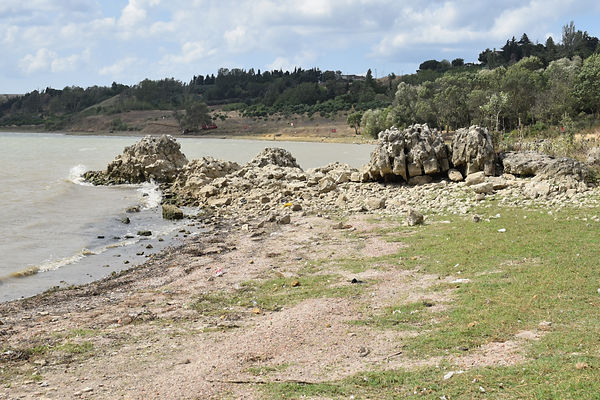Episcopia Fortress
Ahmediye Kalesi
The remains of a large Byzantine fortress are located in the village of Ahmediye on the northwestern shore of Lake Büyükçekmece. This could be the remains of the Episcopia Fortress built by Justinian, which Procopius mentioned was near Athyras (modern Büyükçekmece).
Episkopeia (Ἐπικοπεῖα) or Episcopia was a fortress near Athyra during the reign of Justinian I (527-565). Procopius records it being built by the silentiarios Theodore. A Byzantine fortress in Ahmediye, a village around 9 km northwest of Athyra (modern Büyükçekmece), is likely this Justinianic fortress. While Episkopeia has also been identified with the fortified town Çatalca, Çatalca was more likely the Byzantine bishopric Metrai. This Eastern Thracian fortress was in the western hinterland of Constantinople.
Located on the northwestern shore of Lake Büyükçekmece (historic Athyra Kolpos), the impressive remains were partially submerged following the construction of the Büyükçekmece Dam in the 1980s. The nearby E80 highway roughly follows the route of the older main branch of the Via Egnatia (the southern branch of the Via Egnatia later passed through Athyra). Located on a fertile plain enriched by alluvial deposits of the Karasu Stream (historic Athyra River), the fortress likely played a role in protecting the farmlands and the Via Egnatia in the area.
The fortress was roughly rectangular in plan. Its walls have a core of mortared rubble that is largely missing its facing, though some ashlar blocks have survived. The walls also have several vertical beam holes and only sporadic use of brick. Its northwest wall was around 465 m, while what survives of the southwest wall is over 200 m. The remains of a gate and tower are on the southwest wall. The foundations of several towers can be found in the submerged sections of the northwest and northeast walls. These towers are roughly 40 to 65 m apart, suggesting the fortification had towers at relatively regular intervals. The longest surviving section of the walls is 28 m long with a width of around 3 m. The surviving height of the walls is between 4.5 and 6.5 m.
Roman funerary steles were discovered near the fortress in the 1980s. It was first surveyed in the 1990s and more extensively in 2016-2018. The artifacts found at the site include Hellenistic and Roman ceramic fragments, a Roman funerary stele, Byzantine columns, horse bones, medieval medical instruments, a medieval mace, and Sgraffito ceramic fragments. The coins found at the site date from the Hellenistic to the Middle Byzantine era. The evidence suggests that a settlement was established here by the Hellenistic era, and the fortification was in use until the end of the Middle Byzantine era.
From On Buildings by Procopius
Beyond Athyras is a certain place which the inhabitants call Episcopia. The Emperor Justinian, perceiving that this lay exposed to the assaults of the enemy, and that a large expanse of country here was altogether unguarded, since no stronghold at all existed, built a fortress in that place; and he built the towers there, not in the customary manner, but as follows. At regular intervals a structure is built out from the circuit-wall, very narrow at first, but finally spreading out to a great breadth; on this in each case a tower was erected. Thus it is impossible for the enemy to get close to the wall anywhere, because when they get into a precarious position between the towers they are easily shot at from both sides and from above by the guards there and are destroyed. The gates too he did not place in the customary position between the towers, but at an angle, in the narrow part of the projection which runs out from the wall, where they could not be seen by the enemy but were masked behind the towers. In that place Theodore, a very clever man who held the office of silentiarius, was of service to the Emperor. Thus were these fortifications built.

Plan from Aydıngün

Google Earth satellite view in 2014
References
Külzer, A. Ostthrakien (Eurōpē), (Tabula Imperii Byzantini 12)
Aydıngün, Ş. et al. “Episkopeia, a Justinianic Fortress in Eastern Thrace-Istanbul Büyükçekmece,” (Jahreshefte des Österreichischen Archäologischen Institutes in Wien 88)
Aydingun, Ş. et al. “Episkopeia Kalesi (Büyükçekmece-Ahmediye),” (Arkeoloji ve Sanat 163)
Sayar, MH. “Doğu Trakya’da Epigrafi ve Tarihi-Coğrafya Araştırmaları 1995,” (Araştırma Sonuçları Toplantıları 14)
Sayar, MH. “Doğu Trakya’da Epigrafi ve Tarihi-Coğrafya Araştırmaları 1999,” (Araştırma Sonuçları Toplantıları 18)
Primary Sources
Procopius: Buildings translated by HB Dewing
Resources
















